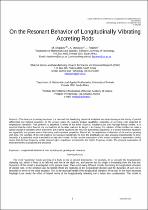JavaScript is disabled for your browser. Some features of this site may not work without it.
- ResearchSpace
- →
- Research Publications/Outputs
- →
- Conference Publications
- →
- View Item
| dc.contributor.author |
Shatalov, M

|
|
| dc.contributor.author |
Manzhirov, A

|
|
| dc.contributor.author |
Fedotov, I

|
|
| dc.date.accessioned | 2014-03-07T10:33:36Z | |
| dc.date.available | 2014-03-07T10:33:36Z | |
| dc.date.issued | 2012-09 | |
| dc.identifier.citation | Shatalov, M, Manzhirov, A and Fedotov, I. 2012. On the resonant behavior of longitudinally vibrating accreting rods. In: 8th South African Conference on Computational and Applied Mechanics (SACAM 2012), Johannesburg, South Africa, 3-5 September 2012 | en_US |
| dc.identifier.uri | http://hdl.handle.net/10204/7276 | |
| dc.description | 8th South African Conference on Computational and Applied Mechanics (SACAM 2012), Johannesburg, South Africa, 3-5 September 2012 | en_US |
| dc.description.abstract | The theory of accreting structures is a new and fast developing branch of analytical mechanics basing on the theory of partial differential and integral equations. In the present paper the authors analyze qualitative properties of accreting rods subjected to longitudinal vibrations. This problem is described it terms of the linear classical, Rayleigh-Love and Rayleigh-Bishop models. It is assumed that the rod is fixed at one end and free at the other end and its length is increasing. For solution of this problem we make a special change of variables which transforms the original equations into new non-autonomous equations. It is shown that these equations are hyperbolic and possess several interesting and important properties. First of all, the amplitudes of vibration of the rod are growing with time. For example, if the rod length is increasing proportionally to time the amplitudes are also growing proportionally to time. Secondly, if a particular mode is excited it excites other modes. In this case the mechanism of the modes excitation is asymmetric, which means that the low frequency modes possess higher amplitudes compared to the higher frequency modes. The physical explanation of these phenomena is proposed and discussed. | en_US |
| dc.language.iso | en | en_US |
| dc.publisher | SACAM 2012 | en_US |
| dc.relation.ispartofseries | Workflow;9835 | |
| dc.subject | Longitudinally vibrating rod | en_US |
| dc.subject | Accreting rods | en_US |
| dc.title | On the resonant behavior of longitudinally vibrating accreting rods | en_US |
| dc.type | Conference Presentation | en_US |
| dc.identifier.apacitation | Shatalov, M., Manzhirov, A., & Fedotov, I. (2012). On the resonant behavior of longitudinally vibrating accreting rods. SACAM 2012. http://hdl.handle.net/10204/7276 | en_ZA |
| dc.identifier.chicagocitation | Shatalov, M, A Manzhirov, and I Fedotov. "On the resonant behavior of longitudinally vibrating accreting rods." (2012): http://hdl.handle.net/10204/7276 | en_ZA |
| dc.identifier.vancouvercitation | Shatalov M, Manzhirov A, Fedotov I, On the resonant behavior of longitudinally vibrating accreting rods; SACAM 2012; 2012. http://hdl.handle.net/10204/7276 . | en_ZA |
| dc.identifier.ris | TY - Conference Presentation AU - Shatalov, M AU - Manzhirov, A AU - Fedotov, I AB - The theory of accreting structures is a new and fast developing branch of analytical mechanics basing on the theory of partial differential and integral equations. In the present paper the authors analyze qualitative properties of accreting rods subjected to longitudinal vibrations. This problem is described it terms of the linear classical, Rayleigh-Love and Rayleigh-Bishop models. It is assumed that the rod is fixed at one end and free at the other end and its length is increasing. For solution of this problem we make a special change of variables which transforms the original equations into new non-autonomous equations. It is shown that these equations are hyperbolic and possess several interesting and important properties. First of all, the amplitudes of vibration of the rod are growing with time. For example, if the rod length is increasing proportionally to time the amplitudes are also growing proportionally to time. Secondly, if a particular mode is excited it excites other modes. In this case the mechanism of the modes excitation is asymmetric, which means that the low frequency modes possess higher amplitudes compared to the higher frequency modes. The physical explanation of these phenomena is proposed and discussed. DA - 2012-09 DB - ResearchSpace DP - CSIR KW - Longitudinally vibrating rod KW - Accreting rods LK - https://researchspace.csir.co.za PY - 2012 T1 - On the resonant behavior of longitudinally vibrating accreting rods TI - On the resonant behavior of longitudinally vibrating accreting rods UR - http://hdl.handle.net/10204/7276 ER - | en_ZA |






